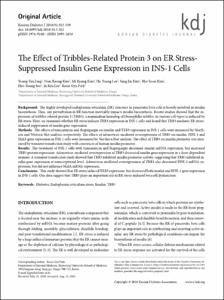KUMEL Repository
1. Journal Papers (연구논문)
1. School of Medicine (의과대학)
Dept. of Internal Medicine (내과학)
The Effect of Tribbles-Related Protein 3 on ER Stress- Suppressed Insulin Gene Expression in INS-1 Cells
- Keimyung Author(s)
- Kim, Mi Kyung; Kim, Hye Soon; Park, Keun Gyu
- Department
- Dept. of Internal Medicine (내과학)
- Journal Title
- Diabetes & Metabolism Journal
- Issued Date
- 2010
- Volume
- 34
- Issue
- 5
- Abstract
- Background: The highly developed endoplasmic reticulum (ER) structure in pancreatic beta cells is heavily involved in insulin
biosynthesis. Thus, any perturbation in ER function inevitably impacts insulin biosynthesis. Recent studies showed that the expression
of tribbles-related protein 3 (TRB3), a mammalian homolog of Drosophilia tribbles, in various cell types is induced by
ER stress. Here, we examined whether ER stress induces TRB3 expression in INS-1 cells and found that TRB3 mediates ER stressinduced
suppression of insulin gene expression.
Methods: The effects of tunicamycin and thapsigargin on insulin and TRB3 expression in INS-1 cells were measured by Northern
and Western blot analysis, respectively. The effects of adenovirus-mediated overexpression of TRB3 on insulin, PDX-1 and
MafA gene expression in INS-1 cells were measured by Northern blot analysis. The effect of TRB3 on insulin promoter was measured
by transient transfection study with constructs of human insulin promoter.
Results: The treatment of INS-1 cells with tunicamycin and thapsigargin decreased insulin mRNA expression, but increased
TRB3 protein expression. Adenovirus-mediated overexpression of TRB3 decreased insulin gene expression in a dose-dependent
manner. A transient transfection study showed that TRB3 inhibited insulin promoter activity, suggesting that TRB3 inhibited insulin
gene expression at transcriptional level. Adenovirus-mediated overexpression of TRB3 also decreased PDX-1 mRNA expression,
but did not influence MafA mRNA expression.
Conclusions: This study showed that ER stress induced TRB3 expression, but decreased both insulin and PDX-1 gene expression
in INS-1 cells. Our data suggest that TRB3 plays an important role in ER stress-induced beta cell dysfunction.
Keywords: Diabetes; Endoplasmic reticulum stress; Insulin; TRB3
- Publisher
- School of Medicine
- Citation
- Young Yun Jang et al. (2010). The Effect of Tribbles-Related Protein 3 on ER Stress-
Suppressed Insulin Gene Expression in INS-1 Cells. Diabetes & Metabolism Journal, 34(5), 312–319. doi: 10.4093/kdj.2010.34.5.312
- Type
- Article
- ISSN
- 2233-6079
- Appears in Collections:
- 1. School of Medicine (의과대학) > Dept. of Internal Medicine (내과학)
- 파일 목록
-
-
Download
 oak-aaa-01610.pdf
기타 데이터 / 192.41 kB / Adobe PDF
oak-aaa-01610.pdf
기타 데이터 / 192.41 kB / Adobe PDF
-
Items in Repository are protected by copyright, with all rights reserved, unless otherwise indicated.